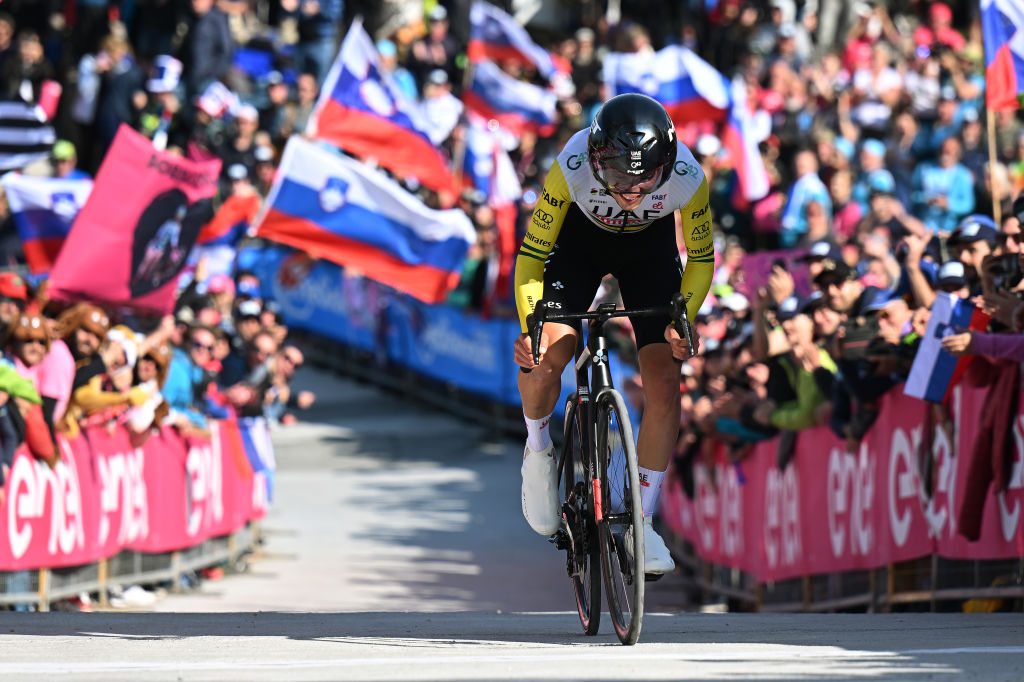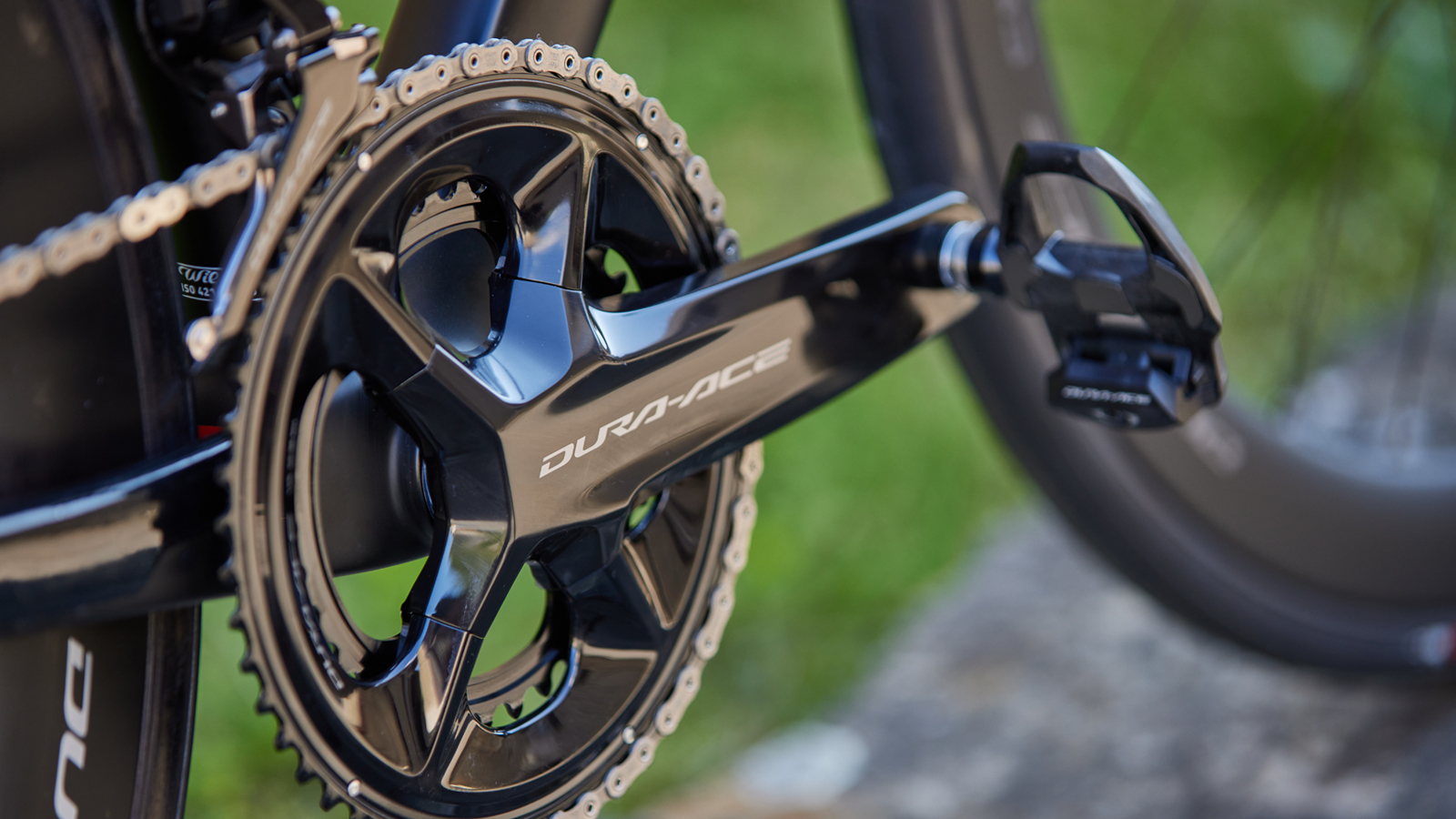
It's been five years since Shimano last updated the Dura-Ace groupset but today that all changes. There've been numerous hints at what was coming and we've stayed abreast of all the patent applications and prototypes. Today we can stop guessing. We now know for sure what the Dura-Ace R9200 looks like and includes, as Shimano has officially - and finally - unveiled new Dura-Ace, alongside new Ultegra R8100.
We've already been hands-on with the new groupset, so read our Dura-Ace R9200 review for our early impressions.
The big headline features are 12-speed electronic-only shifting and a semi-wireless design but there are plenty of details beyond that. The concept that drives the design goes by the name "the science of speed," an idea that Shimano says encompasses "researching, investigating and analysing product performances in the laboratory and the real world". The knowledge gained is then applied towards the goal of delivering a "faster, more reliable, and more intuitive ride experience."
Dura-Ace has long sat at the very top of Shimano's road groupsets hierarchy and its current and previous iterations have been considered by many as the best road bike groupsets available, but as competitors SRAM and Campagnolo have stepped up to bigger sprockets and newer technologies, how does Shimano's latest update compare and compete?
New Dura-Ace: Key updates
- New Dura-Ace is 12-speed
- It is 'semi-wireless' with cables connecting the derailleurs and the battery, while the shifters connect wirelessly, powered by a coin-cell battery
- There will be no new mechanical Dura-Ace. It is an electric-only groupset.
- A rim brake option remains
- The 'standard' 53/39 is no longer, replaced by 54/40.
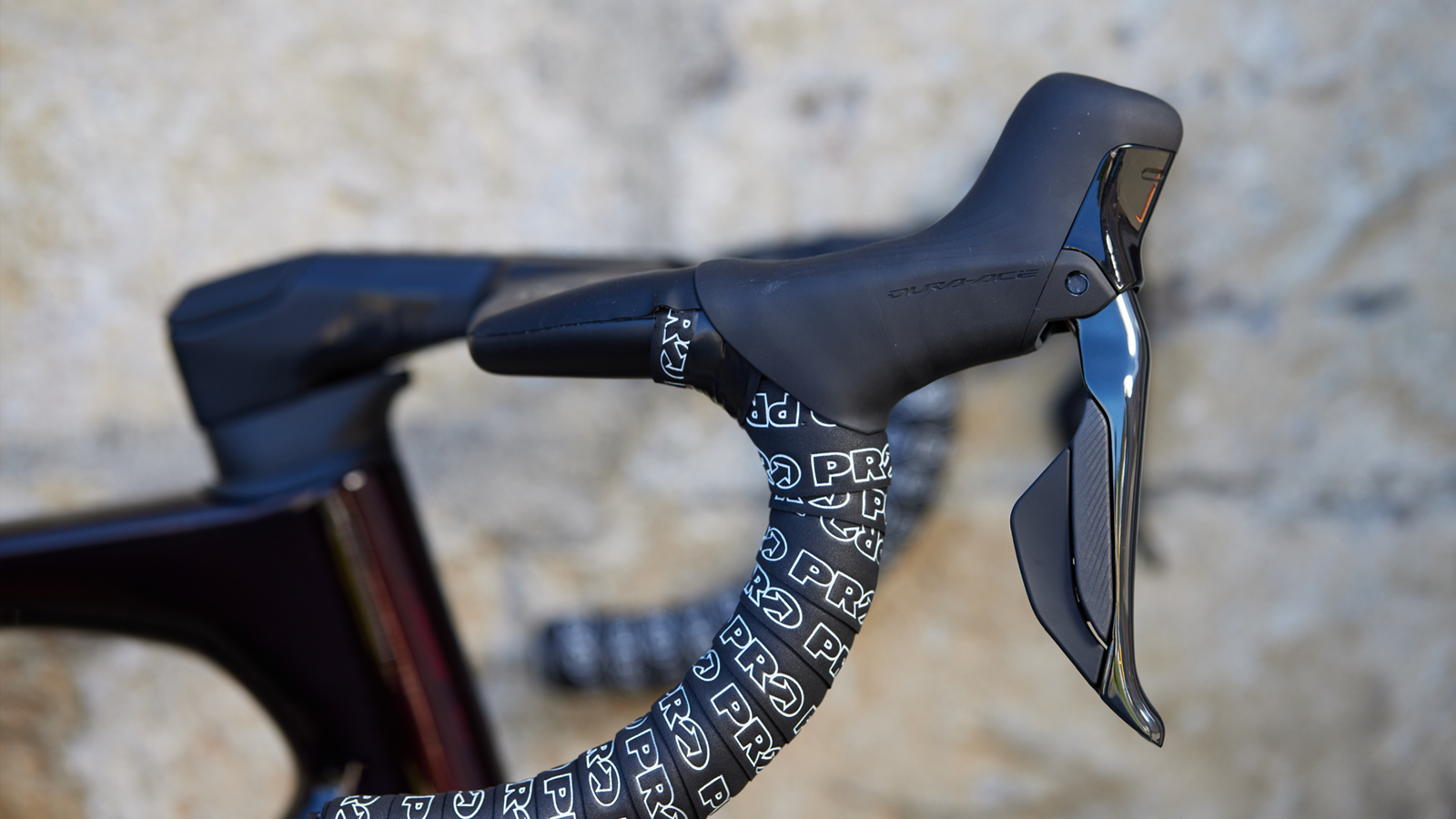
Semi-wireless design
Dura-Ace R9200 no longer requires a wired connection between the cockpit controls and the derailleurs. Instead, the new smaller diameter SD-300 wires connect the Di2 battery (BT-DN300) to the front derailleur (FD-R9250) and rear derailleur (RD-R9250). The rear derailleur then becomes the master device for this part of the system.
The configuration means a battery life that is claimed to last at least 1000km between charges (distance: 45km/day, riding time: 2h/day, FD shifts: 54 times/day, RD shifts: 370 times/day), as well as a simplification of the system. The RD-R9250 rear derailleur provides the connection to the STI shifters via Shimano’s proprietary integrated circuit, the ANT+ connection to other 3rd party devices, and includes an integrated hidden charging port.
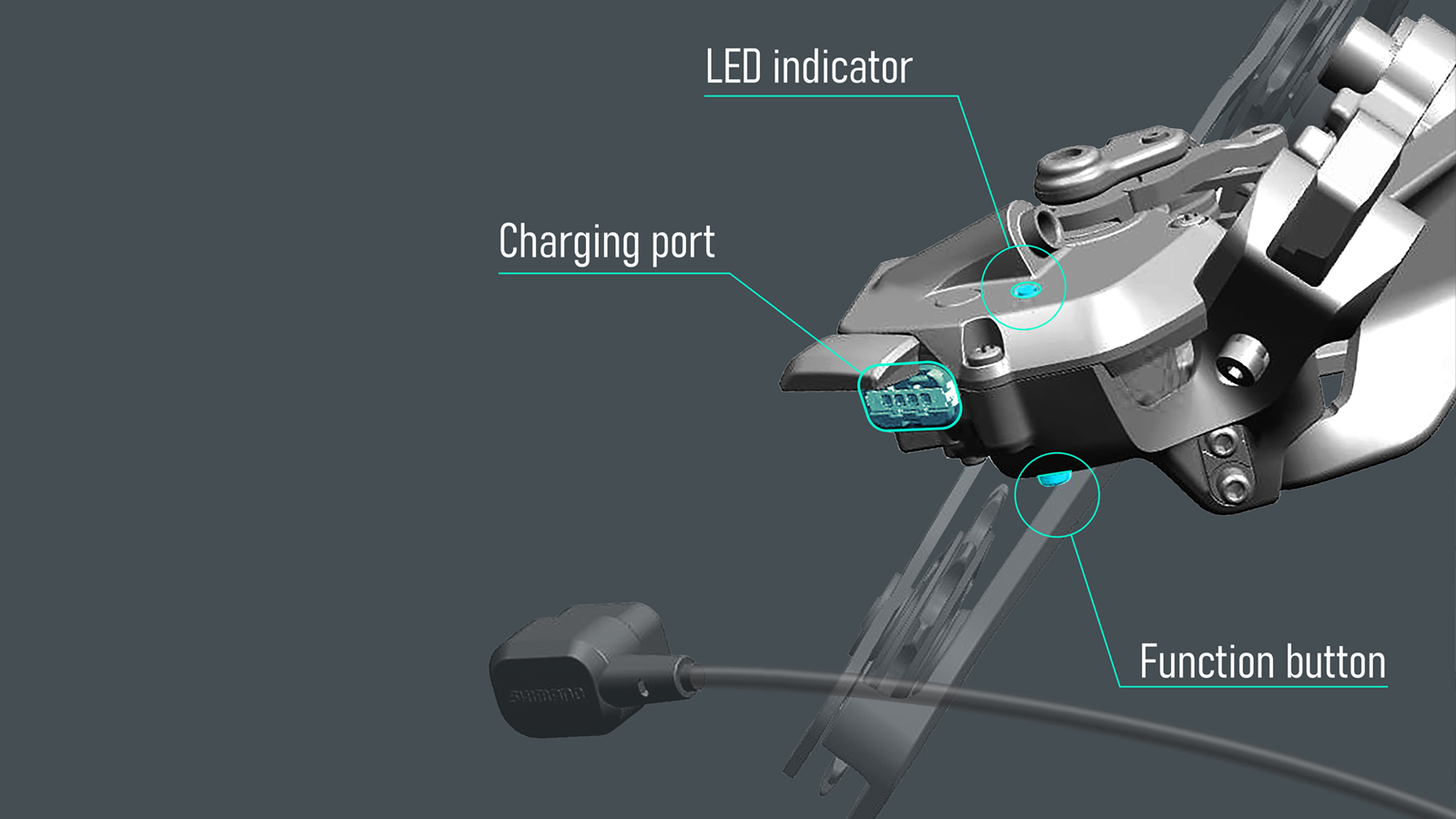
It replaces the SM-BCR2 charger, EW-WU111 wireless unit, and the handlebar/inframe Junction-A (SM-RS910). It also houses a button for Di2 operations and LED lights which denote Synchronized Shifting mode, settings mode, or any charging requirements.
The latest race content, interviews, features, reviews and expert buying guides, direct to your inbox!
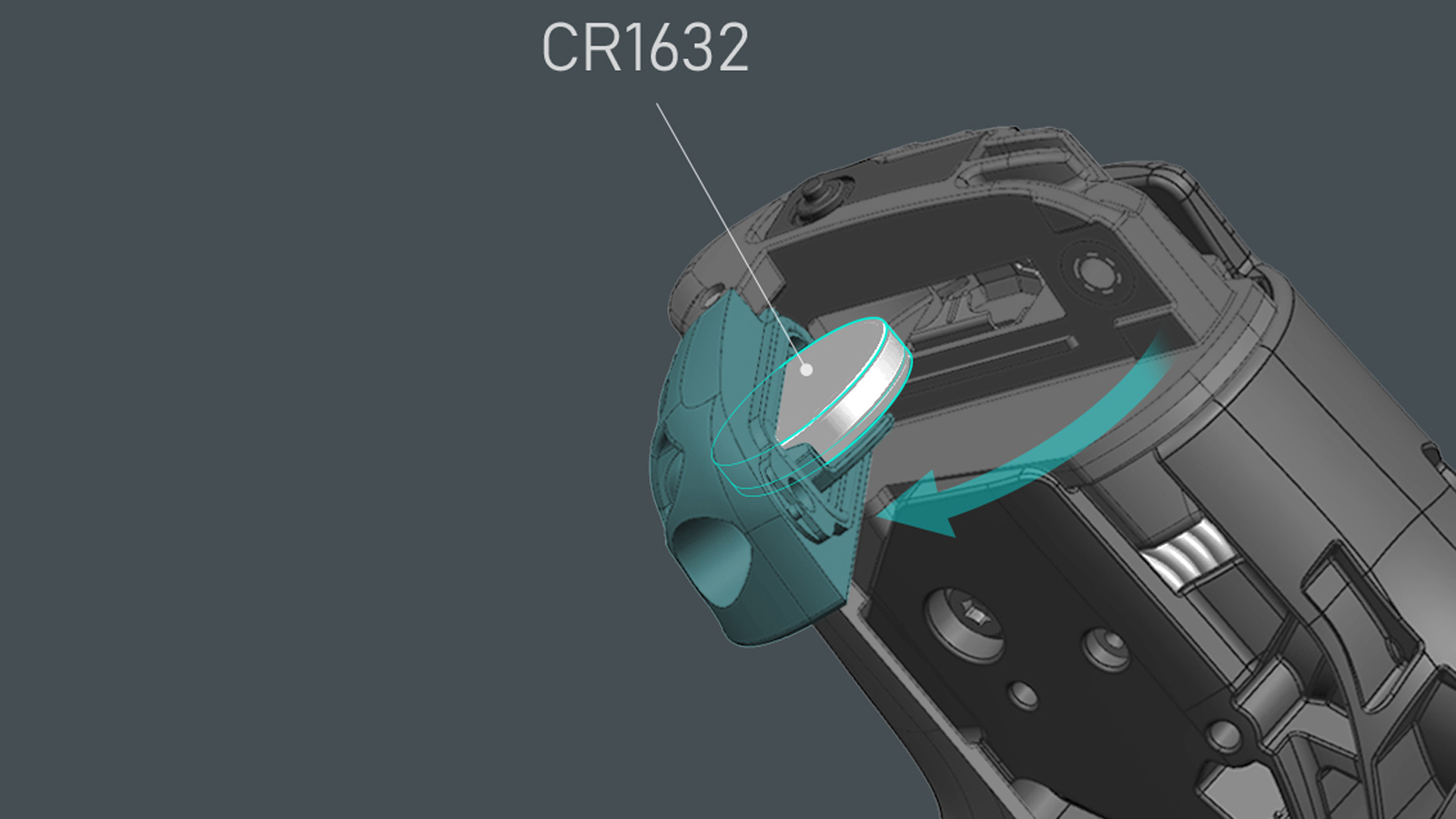
Powering the STI shifter buttons is a CR1632 coin-style battery on each side. The expected battery life for the front controls is approximately 18 months to two years of usage. The lack of wires should help clean up the front end of a bike but Shimano has reasons beyond battery life for keeping the rest of the system wired.
Shimano’s new Di2 platform brings an improved motor design in the derailleurs. The goal of the update is a decrease in the processing speed, i.e. the moving time between motor and gear mechanisms, and the transmission performance. The result is a time saving in fractions of a second that is nonetheless a big saving comparatively. At the rear, Shimano has realized a 58 per cent decrease in rear derailleur operating time and at the front, a 45 per cent decrease in front derailleur operating time.
In order to realise these speed improvements, Shimano needed to ensure battery performance. The larger battery is said to provide a stable, and high voltage, connection to the derailleurs, with reliability further guaranteed by a high security, fast processing and low power consumption proprietary chip circuit, which significantly decreases the chance of interference from external devices.
While the shifters operate with a wireless connection, remote shifter buttons still use cable ports. Shimano’s sprint (SW-R801-S) or climbing shifter (SW-R801-T) have the option of a clamp band or can sit integrally in the handlebars with a specific port, such as the new PRO Vibe Evo bar. These new more compact satellite shifter options either attach to the drops via a 100mm cable (SW-RS801-S) or to the tops via a 260 mm Di2 cable (SW-RS801-T).
One aspect of the design that carries over from existing DI2 designs is the control interface customisation. The E-Tube app received an update and is now compatible with Dura-Ace R9200-series. E-Tube Project version 4.0.0 continues to allow for preferences such as Synchronized or Semi-Synchro shifting, Multi-Shift, shifting speed and STI shift button mapping to be set up on the go. Also, connections with 3rd party cycle computers can all be set up to display Di2 information.
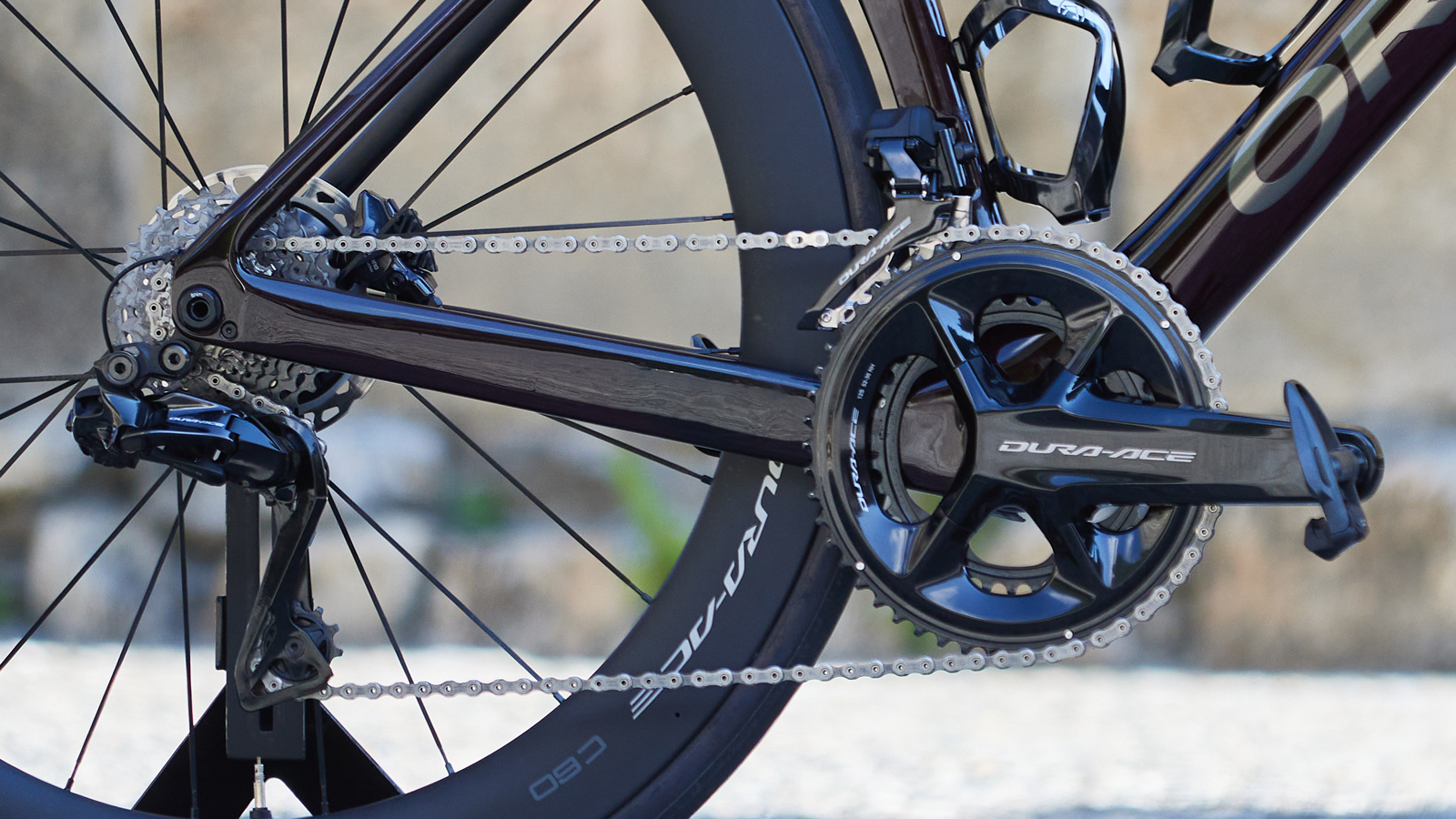
New gearing options
The new system is semi-wireless but moving to a 12-speed drivetrain is, arguably, an even bigger move. Making it work means new gearing options. Speculation was that Shimano would move a 10T cassette following SRAM however that has not been borne out.
The new Dura-Ace 12-speed Hyperglide+ cassette retains the top 11T gear. Instead, the change comes in a revision of the ‘sweet spot’ gears between the 6th, 7th and 8th sprockets. Shimano claims the new design means that Hyperglide+ technology can shift smoothly under load and that there is no longer any need to back off acceleration or time an easy pedal stroke with your shifts.
In total there are two Dura-Ace Hyperglide+ cassette options; 11-30T and a new Dura-Ace 11- 34T ratio for steep climbs. The cassettes come with a new spline fitting pattern, which is also backwards compatible with Dura-Ace R9100 11-speed freehub bodies, meaning that new Dura-Ace R9200 components will continue to work with any previous R9100-series compatible wheels.
As well as the new larger Dura-Ace cassette (11-34T) a new larger 54-40T chainset option is now on offer. Shimano sees advantages of higher transmission efficiency using a larger chainring option paired with a larger cassette and has redesigned the front derailleur to make it all work.
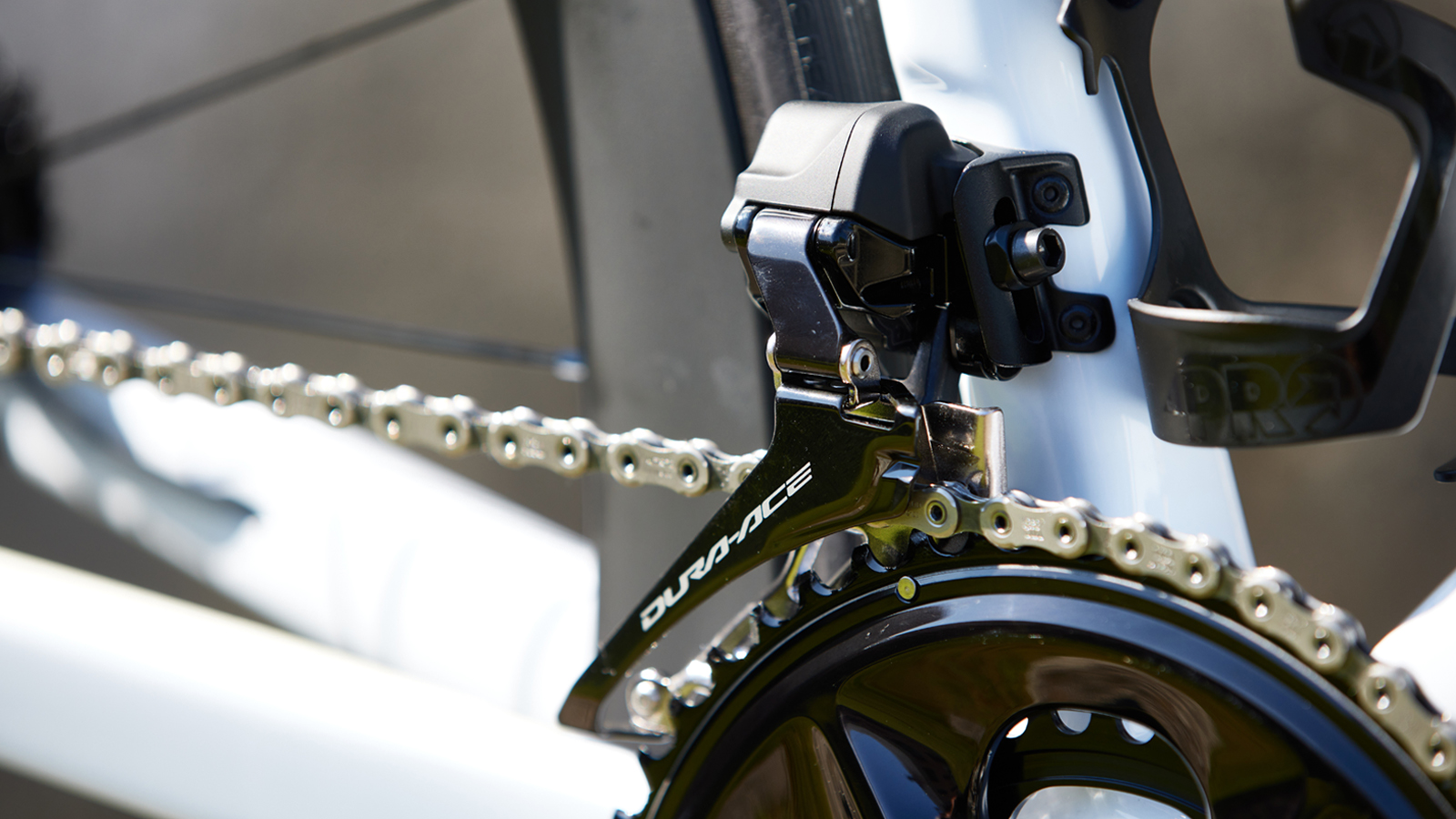
Upfront, shifts are now performed by a smaller, sleeker and lighter Di2 front derailleur (FD-R9250). The front derailleur claims to have a 33 per cent smaller frontal area, weighs just 96 grams, and is compatible with chainrings up to 55T.
As for the cranksets, two versions are available, the integrated power meter version (FC-R9200-P) or the non-power meter version (FC-R9200). Both versions feature Hollowtech II technology, and come in either 50/34T, 52/36T or the new 54/40T chainring combination, in crank arm lengths from 160 to 177.5 mm and with a Q-factor of 148 mm. The power meter version uses Bluetooth and ANT+ technology to transmit data. It boasts 300+ hours of ride time between charges and comes with an improved 1.5 per cent strain gauge accuracy.
Powering the new gearing options is the same chain borrowed from Shimano Mountain bike options. Using Shimano’s XTR M9100 series chain means simplifying inventory requirements for retailers. It also makes shopping easier for riders.
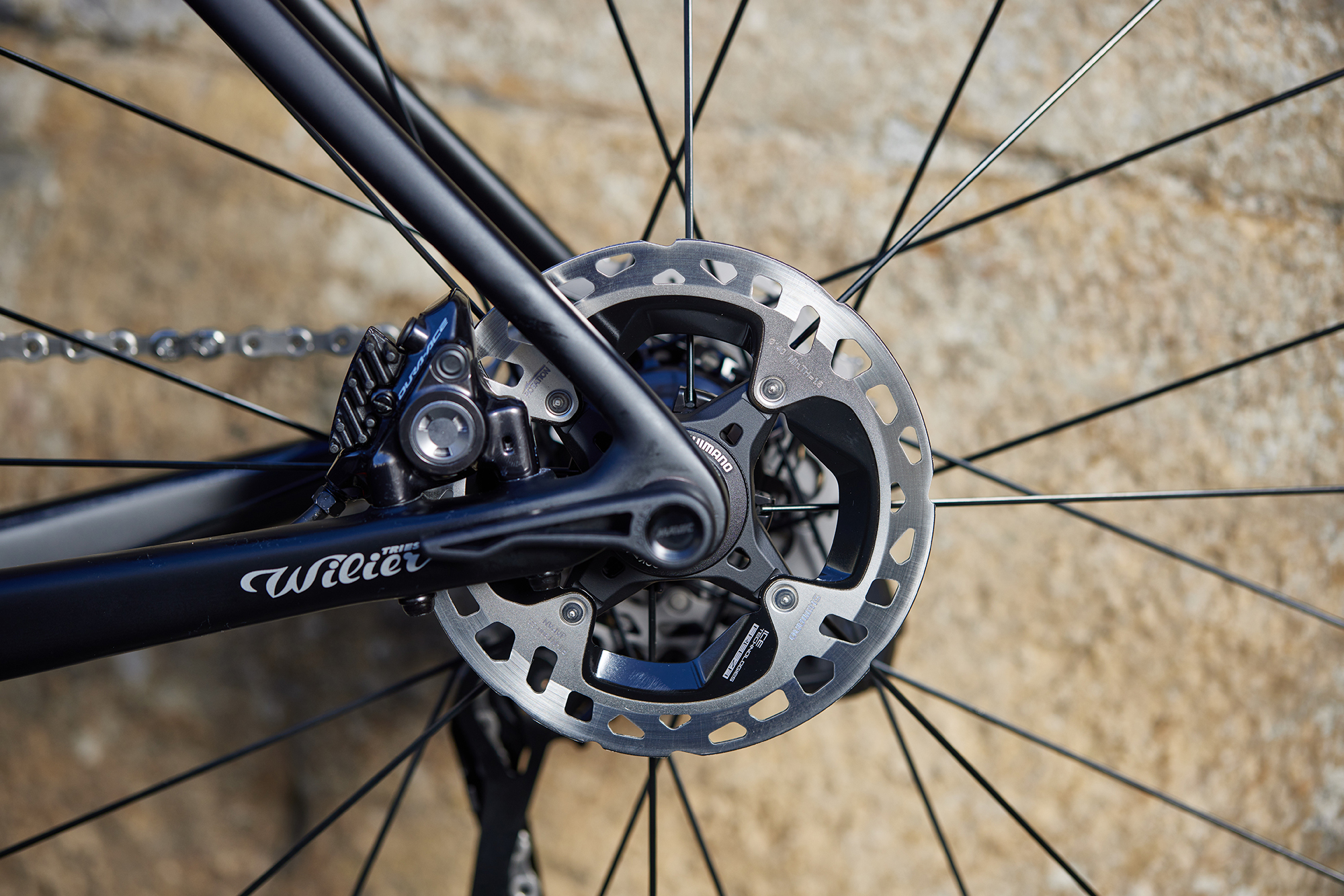
Disc brakes get updated and rim brakes remain available
While mechanical shifting is gone, rim brakes remain an option. For those using discs, there are a host of updates starting with an updated lever action. Taken from Shimano’s MTB and Gravel braking systems, Servowave means a shorter free stroke and a more immediate connection between brake pads and rotors. When you pull a Servowave brake lever, initial pad travel is fast, so only a little lever movement brings the pads into contact with the rotor. The power multiplication factor then increases rapidly at the pad-to-rim contact so more of the lever stroke applies greater braking power with improved control.
In addition, a 10 per cent wider brake pad and rotor clearance and a switch towards Shimano’s RT-MT900 rotors results in a quieter system. Less heat deformation of the rotor and less temporary interference between the pad and the rotor means less noise but should also mean less maintenance. Brake maintenance also improves with the addition of a separate bleed port and valve screw added to the caliper (BR-R9270).
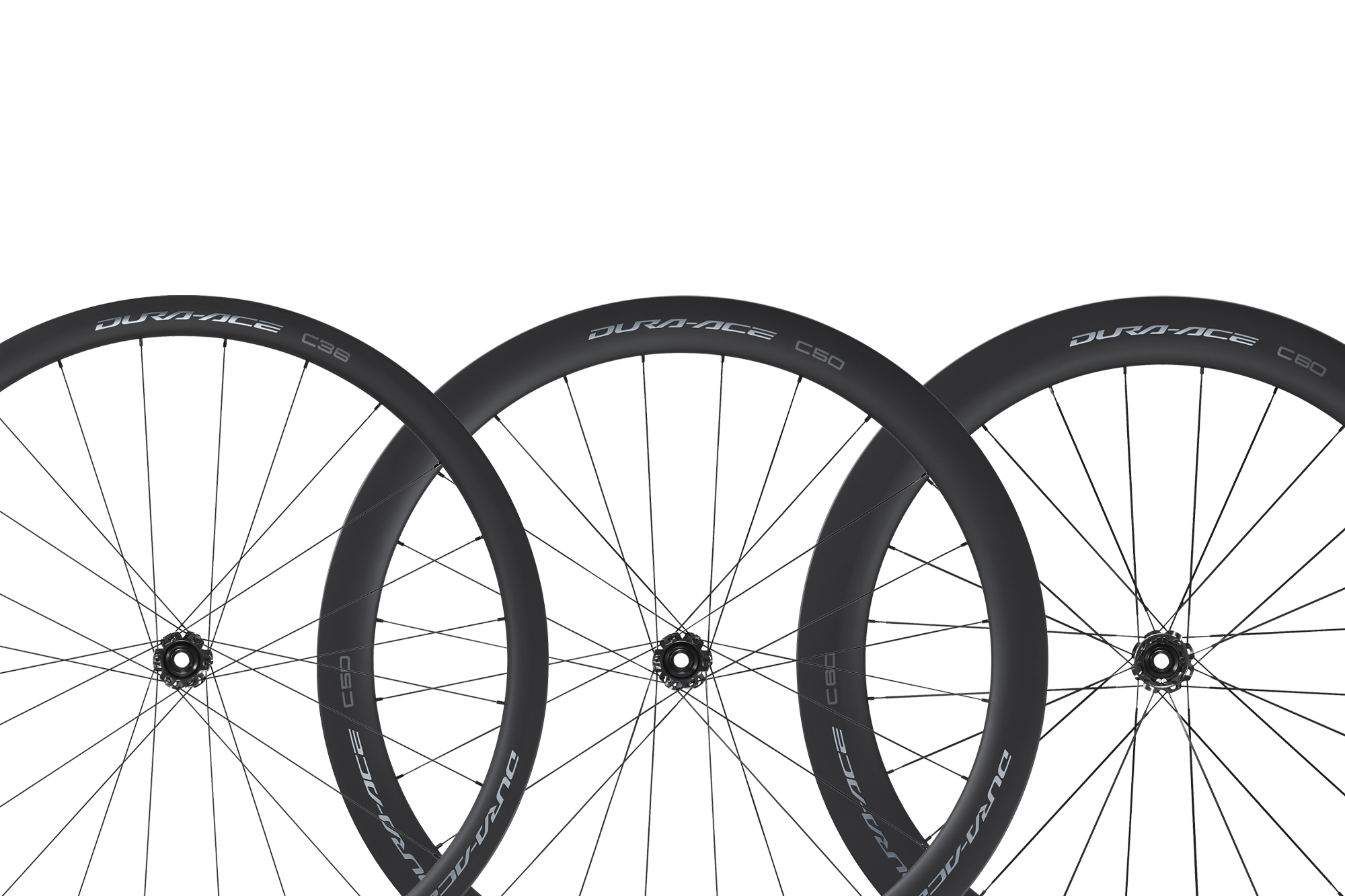
Updated wheels
The final piece of the updated Dura-Ace groupset is new wheels. Choose from the C36, C50, or C60 with rim brake tubular, disc brake tubular, and disc brake tubeless for a total of nine options. Each depth features a 21mm internal width and full carbon rim with a redesigned freehub. The emphasis is on shedding weight while adding rigidity and aerodynamics.
Shimano’s new Direct Engagement freehub structure provides increased driving rigidity. Pedalling feel is more responsive but weight is down by 45 grams as well. The full carbon rims, new spokes and nipples drop the overall weight of the new C50-TL wheels by over 161 grams compared to the current, shallower, C40-TL wheels.
Starting with the C36, this is the climber's wheel, at 1,350g. Spoke lacing is 1:1 standard on the front and 2:1 Optbal in the rear.
The C50 is the all-rounder, with the mid-depth offering improved aerodynamics, while the weight sits at 1,461g. Despite the lighter weight, the C50-TL realises a five-watt reduction in drag compared to the current C40-TL. Spoke lacing is 1:1 standard on the front and 2:1 Optbal in the rear.
Finally, the C60 is the aerodynamic choice. It's an aero wheel with optimised rigidity for sprinting, high-speed pursuits, and larger riders. Front and rear 2:1 spoke pattern adds a 10 per cent increase in rigidity while thicker 2.0-1.8-2.0mm spokes account for another 10 per cent increase in rigidity. Compared to the C40-TL there's an overall 63 per cent increase in driving rigidity while remains controlled at 1,609g.
Pricing, availability, and weights
Official availability begins world-wide in October 2021.
| Header Cell - Column 0 | Header Cell - Column 1 | MSRP | Weight |
|---|---|---|---|
| Drivetrain | Row 0 - Cell 1 | Row 0 - Cell 2 | Row 0 - Cell 3 |
| FC-R9200 | Dura-Ace Cranksets with Chainrings | $624.99 / £549.99 | 680g |
| FC-R9200-P | Dura-Ace Power Meter Crankset with Chainrings | $1,469.99 / £1,199.99 | 754g |
| ST-R9250 | Dura-Ace Di2 Shift/Rim Brake Lever Set (Left and Right) | $784.99 / £699.99 | N/A |
| ST-R9270 | Dura-Ace Di2 Shift/Disc Brake Lever Set (Left and Right) | $1,099.98 / £1,199.98 | 350g |
| CS-R9200 | Dura-Ace Cassette (11-28/30/34) | $359.99 / £329.99 | 223g |
| FD-R9250 | Dura-Ace Di2 Front Derailleur | $449.99 / £399.99 | 96g |
| RD-R9250 | Dura-Ace Di2 Rear Derailleur | $814.99 / £699.99 | 215g |
| Row 8 - Cell 0 | Row 8 - Cell 1 | Row 8 - Cell 2 | Row 8 - Cell 3 |
| Brakes | Row 9 - Cell 1 | Row 9 - Cell 2 | Row 9 - Cell 3 |
| BR-R9200 | Rim Brake Caliper Set | $394.99 / £359.98 | N/A |
| BR-R9270 | Hydraulic Disc Brake Caliper Set | $364.98 / £269.98 | 233g |
| RT-MT900 | Disc Brake Rotor (140mm and 160mm) | $81.99 / £59.99 | 212g |
| Row 13 - Cell 0 | Row 13 - Cell 1 | Row 13 - Cell 2 | Row 13 - Cell 3 |
| Wheels | Row 14 - Cell 1 | Row 14 - Cell 2 | Row 14 - Cell 3 |
| WH-R9270-C36-TL | Dura-Ace C36 Tubeless Disc Brake Wheelset | $2099.99 / £1,799.98 | 1,350g |
| WH-R9270-C50-TL | Dura-Ace C50 Tubeless Disc Brake Wheelset | $2,099.99 / £1,799.98 | 1,461g |
| WH-R9270-C60-HR-TL | Dura-Ace C60 Tubeless Disc Brake Wheelset | $2,199.99 / £1,799.98 | 1,609g |
| Row 18 - Cell 0 | Row 18 - Cell 1 | Row 18 - Cell 2 | Row 18 - Cell 3 |
| Di2 Parts | Row 19 - Cell 1 | Row 19 - Cell 2 | Row 19 - Cell 3 |
| BT-DN300 | Di2 Battery | $184.99 / £174.99 | 53g |
| EW-EC300 | Di2 Charger | $49.99 / £49.99 | Row 21 - Cell 3 |
| SW-RS801-S | Shift Switch for Drops (pair) | $139.99 / £199.99 | Row 22 - Cell 3 |
| SW-RS801-T | Shift Switch for Tops (pair) | $139.99 / £199.99 | Row 23 - Cell 3 |
Josh hails from the Pacific Northwest of the United States but would prefer riding through the desert than the rain. He will happily talk for hours about the minutiae of cycling tech but also has an understanding that most people just want things to work. He is a road cyclist at heart and doesn't care much if those roads are paved, dirt, or digital. Although he rarely races, if you ask him to ride from sunrise to sunset the answer will be yes.
Height: 5'9"
Weight: 140 lb.
Rides: Salsa Warbird, Cannondale CAAD9, Enve Melee, Look 795 Blade RS, Priority Continuum Onyx

